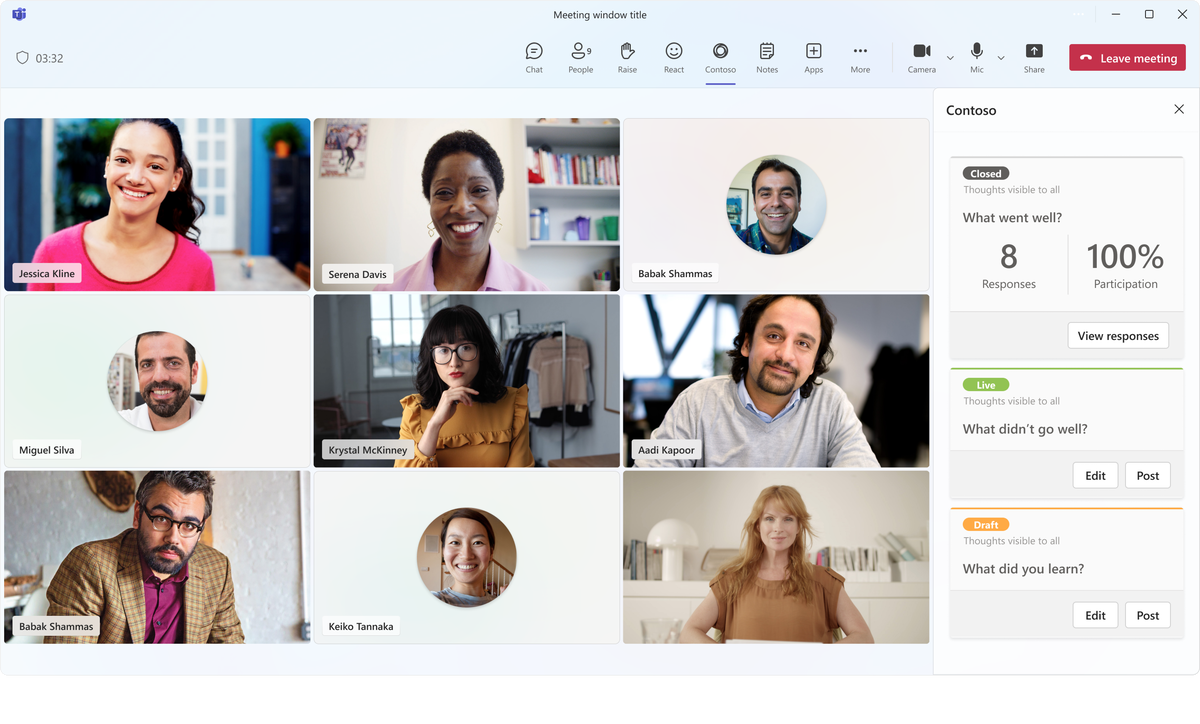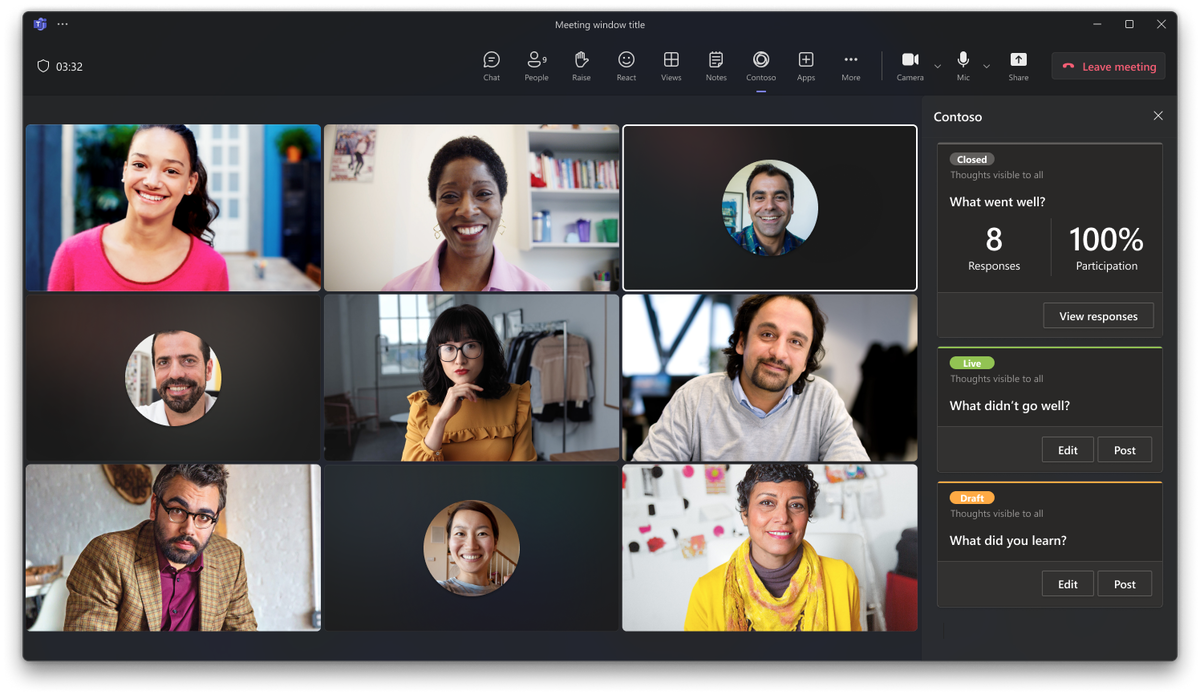Get context for your tab
Your tab requires contextual information to display relevant content:
- Basic information about the user, team, or company.
- Locale and theme information.
- The
page.idandpage.subPageIdthat identify what is in this tab (known asentityIdandsubEntityIdbefore TeamsJS v2.0.0).
Context about the user, team, or company can be especially useful when:
- You create or associate resources in your app with the specified user or team.
- You initiate an authentication flow from Microsoft Entra ID or other identity provider, and you don't require the user to enter their username again.
For more information, see authenticate a user in your Microsoft Teams.
Importante
Although this user information can help provide a smooth user experience, you must not use it as proof of identity. For example, an attacker can load your page in a browser and render harmful information or requests.
You can access context information in two ways:
- Using URL placeholder values.
- From the Microsoft Teams JavaScript client library context object.
Use placeholders in your configuration or content URLs. Microsoft Teams replaces the placeholders with the relevant values when determining the actual configuration or content URL. The available placeholders include all fields on the context object. Common placeholders include the following properties:
- {page.id}: The developer-defined unique ID for the page defined when first configuring the page. (Known as
{entityId}before TeamsJS v2.0.0). - {page.subPageId}: The developer-defined unique ID for the subpage this content points defined when generating a deep link for a specific item within the page. (Known as
{subEntityId}before TeamsJS v2.0.0). - {user.loginHint}: A value suitable as a sign in hint for Microsoft Entra ID. This is usually the sign in name of the current user in their home tenant. (Known as
{loginHint}before TeamsJS v2.0.0). - {user.userPrincipalName}: The User Principal Name of the current user in the current tenant. (Known as
{userPrincipalName}before TeamsJS v2.0.0). - {user.id}: The Microsoft Entra object ID of the current user in the current tenant. (Known as
{userObjectId}before TeamsJS v2.0.0). - {app.theme}: The current user interface (UI) theme such as
default,dark, orcontrast. (Known as{theme}before TeamsJS v2.0.0). - {team.groupId}: The ID of the Microsoft 365 group in which the tab resides. (Known as
{groupId}before TeamsJS v2.0.0) - {user.tenant.id}: The Microsoft Entra tenant ID of the current user. (Known as
{tid}before TeamsJS v2.0.0). - {app.locale}: The current locale of the user formatted as languageId-countryId, for example
en-us. (Known as{locale}before TeamsJS v2.0.0).
Nota
- The previous
{upn}placeholder is now deprecated. For backward compatibility, it's a synonym for{user.loginHint}. - Mobile (Android and iOS) versions of Microsoft Teams support only TeamsJS v1.x.x placeholders.
For example, in your app manifest if you set your tab configurationUrl attribute to "https://www.contoso.com/config?name={user.loginHint}&tenant={user.tenant.id}&group={team.groupId}&theme={app.theme}" and the signed-in user has the following attributes:
- Their username is user@example.com.
- Their company tenant ID is e2653c-etc.
- They're a member of the Microsoft 365 group with ID 00209384-etc.
- The user has set their Teams theme to dark.
Teams calls the following URL when configuring the tab:
https://www.contoso.com/config?name=user@example.com&tenant=e2653c-etc&group=00209384-etc&theme=dark
You can also retrieve the context information using the Microsoft Teams JavaScript client library.
The information can be retrieved by calling microsoftTeams.app.getContext().then((context) => {/*...*/});.
The following code provides an example of context variable:
{
"app": {
"host": {
"clientType": "The type of host client. Possible values are android, ios, web, desktop, surfaceHub, teamsRoomsAndroid, teamsPhones, teamsDisplays rigel (deprecated, use teamsRoomsWindows instead)",
"name": "",
"ringId": "The current ring ID",
"sessionId": "The unique ID for the current Teams session for use in correlating telemetry data" },
"iconPositionVertical": "",
"locale": "The current locale of the user formatted as languageId-countryId (for example, en-us)",
"osLocaleInfo": "",
"parentMessageId": "The parent message ID from which this dialog is launched",
"sessionId": "The unique ID for the current session used for correlating telemetry data",
"theme": "The current UI theme: default | dark | contrast",
"userClickTime": "",
"userFileOpenPreference": "" },
"channel": {
"defaultOneNoteSectionId": "The OneNote section ID that is linked to the channel",
"displayName": "The name of the current channel",
"id": "The channel ID in the format 19:[id]@thread.skype",
"membershipType": "",
"ownerGroupId": "",
"ownerTenantId": "",
"relativeUrl": "The relative path to the SharePoint folder associated with the channel" },
"chat": { "id": "The chat ID in the format 19:[id]@thread.skype" },
"meeting": {
"id": "The meeting ID used by tab when running in meeting context" },
"page": {
"frameContext": "The context where tab URL is loaded (for example, content, task, setting, remove, sidePanel)",
"id": "The developer-defined unique ID for the entity this content points to",
"isFullScreen": "Indicates if the tab is in full-screen",
"isMultiWindow": "The indication whether the tab is in a pop out window",
"sourceOrigin": "",
"subPageId": "The developer-defined unique ID for the sub-entity this content points to" },
"sharepoint": "The SharePoint context is available only when hosted in SharePoint",
"sharepointSite": {
"domain": "The domain of the root SharePoint site associated with the team",
"path": "The relative path to the SharePoint site associated with the team",
"url": "The root SharePoint site associated with the team" },
"team": {
"displayName": "The name of the current team",
"groupId": "Guid identifying the current Office 365 Group ID",
"internalId": "The Microsoft Teams ID in the format 19:[id]@thread.skype",
"isArchived": "Indicates if team is archived",
"templateId": "",
"type": "The type of team",
"userRole": "The user's role in the team" },
"user": {
"displayName": "",
"id": "The Azure AD object id of the current user, in the current tenant",
"isCallingAllowed": "Indicates if calling is allowed for the current logged in user",
"isPSTNCallingAllowed": "Indicates if PSTN calling is allowed for the current logged in user",
"licenseType": "The license type for the current user. Possible values are E1, E3, and E5 enterprise plans",
"loginHint": "A value suitable as a login hint for Azure AD. This is usually the login name of the current user, in their home tenant",
"tenant": {
"id": "The Azure AD tenant ID of the current user",
"teamsSku": "The license type for the current user tenant. Possible values are enterprise, free, edu, unknown" },
"userPrincipalName": "The principal name of the current user, in the current tenant" }
}
import { app, Context } from "@microsoft/teams-js";
app.getContext().then((context: Context) => {
/*...*/
});
Equivalent async/await pattern:
import { app, Context } from "@microsoft/teams-js";
async function example() {
const context: Context = await app.getContext();
/*...*/
}
import { app, Context } from "@microsoft/teams-js";
app.getContext().then((context) => {
/*...*/
});
Equivalent async/await pattern:
import { app, Context } from "@microsoft/teams-js";
async function example() {
const context = await app.getContext();
/*...*/
}
The following table lists commonly used context properties of the context object:
| TeamsJS v2 name | TeamsJS v1 name |
|---|---|
| team.internalId | teamId |
| team.displayName | teamName |
| channel.id | channelId |
| channel.displayName | channelName |
| chat.id | chatId |
| app.locale | locale |
| page.id | entityId |
| page.subPageId | subEntityId |
| user.loginHint | loginHint |
| user.userPrincipalName | upn |
| user.id | userObjectId |
| user.tenant.id | tid |
| team.groupId | groupId |
| app.theme | theme |
| page.isFullScreen | isFullScreen |
| team.type | teamType |
| sharepointSite.teamSiteUrl | teamSiteUrl |
| sharepointSite.teamSiteDomain | teamSiteDomain |
| sharepointSite.teamSitePath | teamSitePath |
| channel.relativeUrl | channelRelativeUrl |
| app.host.sessionId | sessionId |
| team.userRole | userTeamRole |
| team.isArchived | isTeamArchived |
| app.host.clientType | hostClientType |
| page.frameContext | frameContext |
| sharepoint | sharepoint |
| user.tenant.teamsSku | tenantSKU |
| user.licenseType | userLicenseType |
| app.parentMessageId | parentMessageId |
| app.host.ringId | ringId |
| app.sessionId | appSessionId |
| user.isCallingAllowed | isCallingAllowed |
| user.isPSTNCallingAllowed | isPSTNCallingAllowed |
| meeting.id | meetingId |
| channel.defaultOneNoteSectionId | defaultOneNoteSectionId |
| page.isMultiWindow | isMultiWindow |
For more information, see Updates to the Context interface and the Context interface API reference.
Nota
Private channels are in private developer preview only.
When your content page is loaded in a private channel, the data you receive from the getContext call is obfuscated to protect the privacy of the channel.
The following fields are changed when your content page is in a private channel:
team.groupId: Undefined for private channelsteam.internalId: Set to the threadId of the private channelteam.displayName: Set to the name of the private channelsharepointSite.url: Set to the URL of a distinct, unique SharePoint site for the private channelsharepointSite.path: Set to the path of a distinct, unique SharePoint site for the private channelsharepointSite.domain: Set to the domain of a distinct, unique SharePoint site domain for the private channelchannel.ownerGroupId: Set to the host team groupId of the private channel
If your page makes use of any of these values, the value of channel.membershipType field must be Private to determine if your page is loaded in a private channel and can respond appropriately.
Nota
teamSiteUrl also works well for standard channels. If your page makes use of any of these values, the value of channelType field must be Shared to determine if your page is loaded in a shared channel and can respond appropriately.
When the content UX is loaded in a shared channel, use the data received from getContext call for shared channel changes. If tab makes use of any of the following values, you must populate the channelType field to determine if the tab is loaded in a shared channel, and respond appropriately.
For shared channels, the groupId value is null, since the host team's groupId doesn't accurately reflect the true membership of the shared channel. To address this, the hostTeamGroupID and hostTenantID properties are newly added and useful for making Microsoft Graph API calls to retrieve membership. hostTeam refers to the Team that created the shared channel. currentTeam refers to Team that the current user is accessing the shared channel from.
For more information about these concepts and shared channels, see shared channels.
Use the following getContext properties in shared channels:
| Property | Description |
|---|---|
channelId |
The property is set to the shared channels thread ID. |
channelType |
The property is set to sharedChannel for shared channels. |
groupId |
The property is null for shared channels. |
hostTenantId |
The property is newly added and describes the host's tenant ID, useful for comparing against the current user's tid tenant ID property. |
hostTeamGroupId |
The property is newly added and describes the host team’s Microsoft Entra group ID, useful for making Microsoft Graph API calls to retrieve shared channel membership. |
teamId |
The property is newly added and set to the thread ID of the current shared team. |
teamName |
The property is set to current shared team's teamName. |
teamType |
The property is set to current shared team's teamType. |
teamSiteUrl |
The property describes the shared channel's channelSiteUrl. |
teamSitePath |
The property describes the shared channel's channelSitePath. |
teamSiteDomain |
The property describes the shared channel's channelSiteDomain. |
tenantSKU |
The property describes the host team’s tenantSKU. |
tid |
The property describes the current user’s tenant ID. |
userObjectId |
The property describes current user’s ID. |
userPrincipalName |
The property describes the current user’s UPN. |
For more information on shared channels, see shared channels.
Importante
- By default, the new Teams client supports light theme for apps in Teams meetings. When the
app.themeproperty in getContext API returns thedefaultvalue, Teams client is in light theme. - Earlier version of Teams clients only support Dark and Contrast theme for apps in Teams meetings.
You can register your app to be informed if the theme changes by calling microsoftTeams.app.registerOnThemeChangeHandler(function(theme) { /* ... */ }).
The theme argument in the function is a string with a value of default, dark, or contrast.
| Sample name | Description | JavaScript |
|---|---|---|
| Tab channel context | This sample shows how to use the contents of tab context object in a private and shared channel. | View |
Feedback su Platform Docs
Platform Docs è un progetto di open source. Selezionare un collegamento per fornire feedback:

